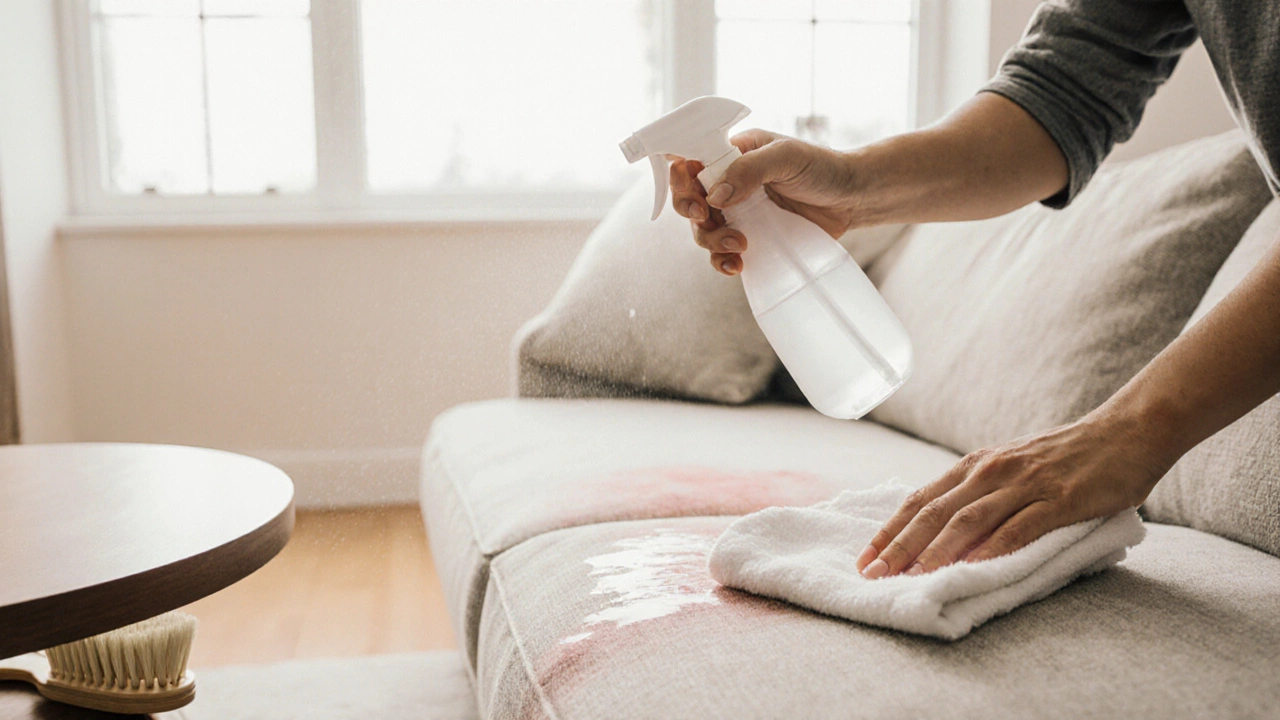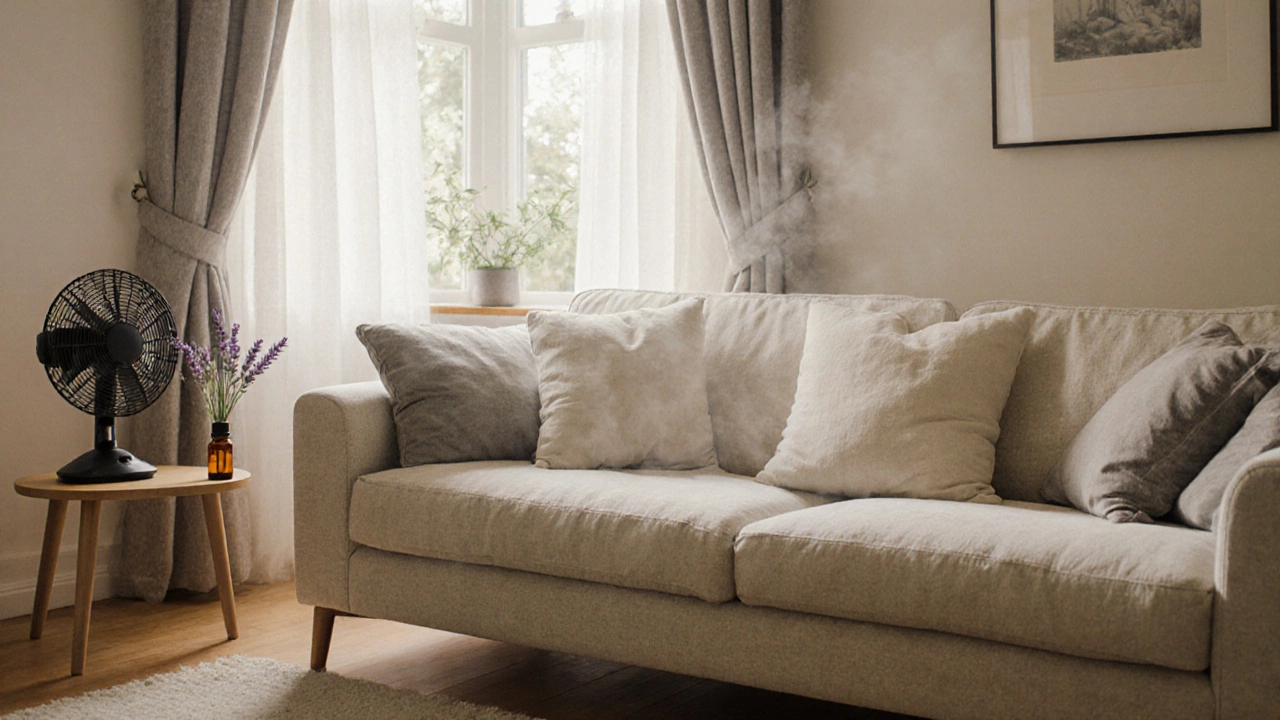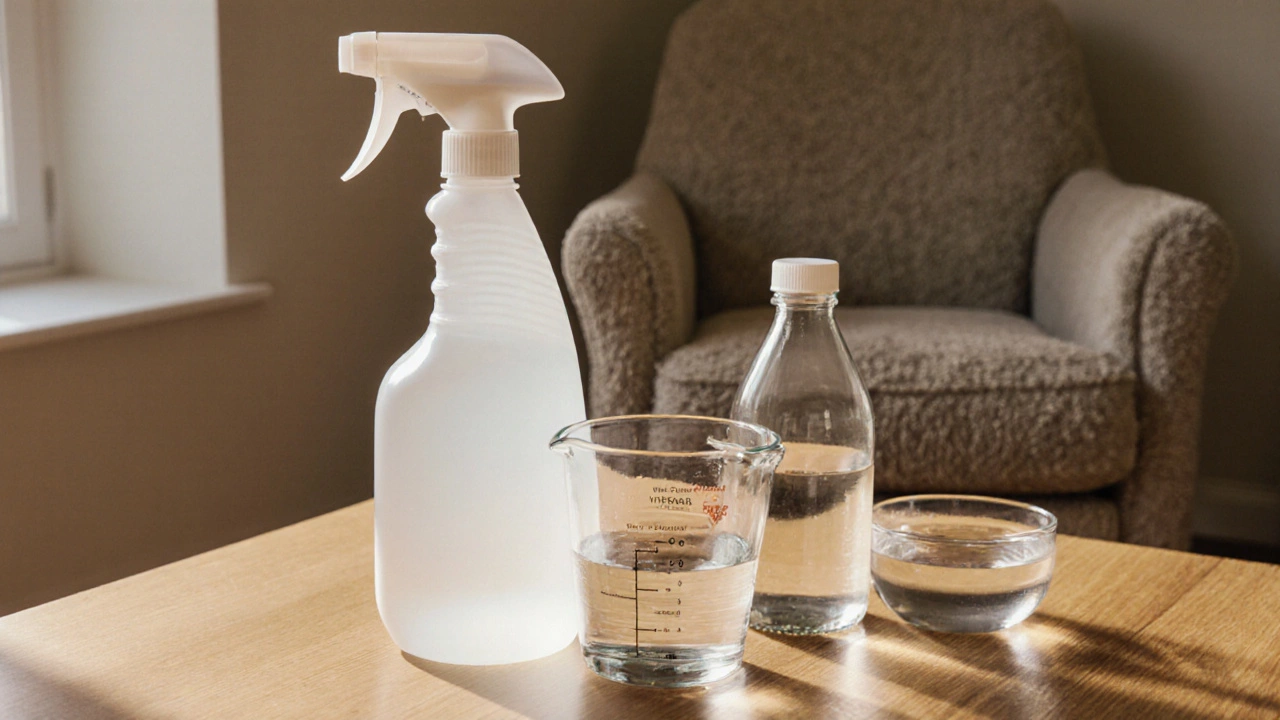Upholstery Cleaner Calculator
Calculate Your Cleaning Solution
Get the perfect vinegar-to-water ratio for your upholstery and stain type. Always test on a hidden area first!
Your Recommended Solution
Safety Warning
Ever wondered if that humble kitchen staple can double as a safe upholstery refresher? The short answer is yes- but only if you follow a few simple rules. This guide walks you through everything you need to know to clean sofas, chairs, and even car seats using a vinegar‑and‑water mix, while avoiding the common pitfalls that turn a quick fix into a fabric nightmare.
What Makes Vinegar a Viable Cleaner?
Vinegar is a weak acid, typically 5‑6% acetic acid, that breaks down grease, lifts light stains, and neutralises odours. Its low pH (around 2.5) means it can dissolve mineral deposits without the harsh chemicals found in many commercial cleaners.
Because it’s biodegradable and inexpensive, vinegar fits perfectly into the eco‑friendly cleaning niche, making it a popular choice for households that want to minimise chemical exposure.
Why Water Matters (And How to Use It)
Water is the universal solvent that dilutes vinegar to a safe concentration for fabrics. Too strong a solution can weaken fibres or cause colour bleeding; too weak, and you’ll see no cleaning effect. The sweet spot is a 1:1 ratio - one part white distilled vinegar to one part lukewarm water.
Using distilled water avoids mineral buildup that could leave spots on dark upholstery, a problem especially noticeable on leather or suede.
Understanding Upholstery Types and Their Tolerance
Upholstery covers a broad range of fabrics, from cotton blends to synthetic mikado, and even natural fibres like hemp. Each reacts differently to moisture and acidity.
- Cotton or linen blends: Generally tolerant of mild acid solutions; they dry quickly.
- Synthetic fibers (polyester, nylon): Resistant to water‑based cleaners; vinegar is safe.
- Leather: Avoid any liquid; use only a barely damp cloth.
- Velvet or silk: Test on an inconspicuous area first; these delicate piles can be damaged by excess moisture.
Knowing your upholstery’s composition helps you decide whether a vinegar‑water spray is appropriate or if you need a specialised cleaner.

Step‑by‑Step: Preparing and Applying the Solution
- Gather supplies: White distilled vinegar, lukewarm distilled water, a clean spray bottle, two soft white cloths, a soft‑bristled brush, and optional baking soda for tough odours.
- Mix the solution: Combine equal parts vinegar and water in the spray bottle. Shake gently to blend.
- Test the fabric: Spray a small, hidden area. Wait 5‑10 minutes; if the colour stays unchanged and the fibre feels normal, you’re good to go.
- Lightly mist the stain: Hold the bottle about 8‑10 inches away and apply a fine mist. Do not soak the fabric - you’re looking for a damp surface, not saturation.
- Blot, don’t rub: Use a white cloth to blot the area, moving from the outside of the stain toward the centre. Rubbing can push the stain deeper.
- Brush gentle fibres: For textured fabrics like boucle or chenille, a soft‑bristled brush can help lift the loosened dirt.
- Rinse with plain water (optional): If a slight vinegar smell remains, lightly mist with plain water and blot again.
- Dry thoroughly: Open windows, use a fan, or place a clean dry towel over the area to absorb excess moisture. Avoid direct heat.
Following these steps keeps the solution effective without over‑wetting the upholstery.
Dealing with Specific Stains
Some stains need a tweak to the basic formula.
| Stain Type | Adjustment | Application Tip |
|---|---|---|
| Pet urine | Add 1 tsp baking soda to the solution | Sprinkle baking soda after the first mist, let fizz, then blot. |
| Wine or coffee | Increase vinegar to 2 parts, water 1 part | d>Apply gently and let sit 2‑3 minutes before blotting.|
| Grease (cooking oil) | Mix in a drop of dish‑soap | Soap helps emulsify oil; rinse with a water‑only mist after. |
| Odour (cigarette smoke) | Combine equal parts vinegar, water, and a few drops of essential oil | Spray lightly; the oil masks any lingering vinegar scent. |

Safety and Precautions
Even natural cleaners can cause issues if misused.
- pH level awareness: Keep the solution near neutral (pH 3‑4). Extreme acidity can weaken denim or cause feather‑proof fabrics to fray.
- Never use on untreated leather or suede - moisture can stain or warp them.
- Avoid applying in direct sunlight; UV can set stains before you have a chance to treat them.
- Ventilate the room to disperse the vinegar smell, which can be strong for up to 30 minutes.
When to Reach for a Professional Cleaner
DIY works for everyday spills and light odours, but some scenarios are best left to pros.
- Large‑area deep cleaning (e.g., whole sofa after a pet accident).
- Stubborn set‑in stains that have baked in for weeks.
- Delicate antiques or heritage fabrics that could be damaged beyond repair.
Professional services often use enzyme‑based cleaners that break down organic stains without harming fibres - a good fallback if your vinegar experiment fails.
Key Takeaways
- Vinegar is a safe, affordable cleaner when diluted 1:1 with water.
- Always test a hidden spot first; different upholstery reacts uniquely.
- Light misting, gentle blotting, and thorough drying are the core steps.
- Adjust the formula for specific stains - baking soda for urine, extra vinegar for wine, a drop of dish‑soap for grease.
- Know the limits: stay away from leather, avoid over‑wetting, and call a pro for severe cases.
Is it safe to use vinegar on colored upholstery?
Yes, as long as you dilute it properly (1 part vinegar to 1 part water) and test an inconspicuous area first. The low acidity won’t strip colour if the fabric is colour‑fast.
Can I use apple cider vinegar instead of white distilled vinegar?
Apple cider vinegar works, but it has a darker hue that could leave a faint tint on light fabrics. White distilled vinegar is preferred for a completely clear solution.
How long should I let the vinegar solution sit on a stain?
Usually 2‑3 minutes is enough. Longer contact can weaken fibres, especially on delicate materials.
Will the vinegar smell linger after cleaning?
The scent evaporates within 30‑45 minutes, especially if the room is ventilated. Adding a few drops of essential oil can speed up the process and leave a pleasant aroma.
Can this method be used on car interior seats?
Absolutely, provided the seats are fabric‑based. For leather car seats, stick to a barely damp cloth and avoid any vinegar solution.
